Fe3O4–Silicone Mixture as Flexible Actuator
Abstract
:1. Introduction
2. Materials and Methods
2.1. Beam Shape Mold Fabrication Using 3D Printer
2.2. Iron Oxide-Silicone Composite Beam Fabrication
2.3. SEM Images and Microanalysis
2.4. Circuit Configuration and Setup
2.5. Motion Tracing of the Silicone Composite Actuator
3. Results
3.1. Material Properties of the Fe3O4-Silicone Composite Actuators
3.2. Motion of Fe3O4-Silicone Composite Actuators
3.2.1. Actuation by High-Voltage Input
3.2.2. Frequency Response and Effect of Voltage input
4. Discussion
5. Conclusions
Author Contributions
Funding
Acknowledgments
Conflicts of Interest
References
- Martinez, R.V.; Glavan, A.C.; Keplinger, C.; Oyetibo, A.I.; Whitesides, G.M. Soft actuators and robots that are resistant to mechanical damage. Adv. Funct. Mater. 2014, 24, 3003–3010. [Google Scholar] [CrossRef]
- Miriyev, A.; Stack, K.; Lipson, H. Soft material for soft actuators. Nat. Commun. 2017, 8, 596. [Google Scholar] [CrossRef] [PubMed]
- Yeo, J.C.; Yap, H.K.; Xi, W.; Wang, Z.; Yeow, C.H.; Lim, C.T. Flexible and stretchable strain sensing actuator for wearable soft robotic applications. Adv. Mater. Technol. 2016, 1, 3. [Google Scholar] [CrossRef]
- Chen, W.; Zhu, Z. Flexible Actuators. In Handbook of Smart Textiles; Springer: Singapore, Singapore, 2015; pp. 381–410. [Google Scholar]
- Ilievski, F.; Mazzeo, A.D.; Shepherd, R.F.; Chen, X.; Whitesides, G.M. Soft robotics for chemists. Angew. Chem. 2011, 123, 1930–1935. [Google Scholar] [CrossRef] [Green Version]
- Martinez, R.V.; Branch, J.L.; Fish, C.R.; Jin, L.; Shepherd, R.F.; Nunes, R.; Suo, Z.; Whitesides, G.M. Robotic tentacles with three-dimensional mobility based on flexible elastomers. Adv. Mater. 2013, 25, 205–212. [Google Scholar] [CrossRef] [PubMed] [Green Version]
- Bartlett, N.W.; Tolley, M.T.; Overvelde, J.T.; Weaver, J.C.; Mosadegh, B.; Bertoldi, K.; Whitesides, G.M.; Wood, R.J. A 3D-printed, functionally graded soft robot powered by combustion. Science 2015, 349, 161–165. [Google Scholar] [CrossRef] [PubMed]
- Yap, H.K.; Lim, J.H.; Nasrallah, F.; Goh, J.C.; Yeow, R.C. A Soft Exoskeleton for Hand Assistive and Rehabilitation Application Using Pneumatic Actuators with Variable Stiffness. In Proceedings of the 2015 IEEE International Conference on Robotics and Automation (ICRA), Seattle, WA, USA, 26–30 May 2015; IEEE: Seattle, WA, USA, 2015; pp. 4967–4972. [Google Scholar]
- Majidi, C. Soft robotics: A perspective—Current trends and prospects for the future. Soft Robot. 2014, 1, 5–11. [Google Scholar] [CrossRef]
- Tan, N.; Gu, X.; Ren, H. Design, characterization and applications of a novel soft actuator driven by flexible shafts. Mech. Mach. Theory 2018, 122, 197–218. [Google Scholar] [CrossRef]
- Mirfakhrai, T.; Madden, J.D.; Baughman, R.H. Polymer artificial muscles. Mater. Today 2007, 10, 30–38. [Google Scholar] [CrossRef]
- Shankar, R.; Ghosh, T.K.; Spontak, R.J. Dielectric elastomers as next-generation polymeric actuators. Soft Matter 2007, 3, 1116–1129. [Google Scholar] [CrossRef]
- Bar-Cohen, Y. Electroactive polymers: Current capabilities and challenges. In Proceedings of the Smart Structures and Materials 2002: Electroactive Polymer Actuators and Devices (EAPAD), San Diego, CA, USA, 11 July 2002; International Society for Optics and Photonics: San Diego, CA, USA, 2002; pp. 1–8. [Google Scholar]
- Bar-Cohen, Y.; Sherrit, S.; Lih, S.-S. Characterization of the electromechanical properties of EAP materials. In Proceedings of the Smart Structures and Materials 2001: Electroactive Polymer Actuators and Devices, Newport Beach, CA, USA, 16 July 2001; International Society for Optics and Photonics: Newport Beach, CA, USA, 2001; pp. 319–328. [Google Scholar]
- Brochu, P.; Pei, Q. Advances in dielectric elastomers for actuators and artificial muscles. Macromol. Rapid Commun. 2010, 31, 10–36. [Google Scholar] [CrossRef] [PubMed]
- Kong, J.; Tong, Y.; Sun, J.; Wei, Y.; Thitsartarn, W.; Jayven, C.C.Y.; Muiruri, J.K.; Wong, S.Y.; He, C. Electrically conductive PDMS-grafted CNTs-reinforced silicone elastomer. Compos. Sci. Technol. 2018, 159, 208–215. [Google Scholar] [CrossRef]
- Rosset, S.; Araromi, O.A.; Schlatter, S.; Shea, H.R. Fabrication process of silicone-based dielectric elastomer actuators. J. Vis. Exp. 2016, 108, 53423. [Google Scholar] [CrossRef] [PubMed]
- Li, Z.; Dong, P.; Shi, T.; Tang, C.; Bian, C.; Chen, H. Elastomeric electrode and casting process for manufacturing multilayer dielectric elastomer actuators. In Proceedings of the Electroactive Polymer Actuators and Devices (EAPAD) XX, Denver, CO, USA, 27 March 2018; International Society for Optics and Photonics: Denver, CO, USA, 2018; p. 1059414. [Google Scholar]
- Do, T.N.; Phan, H.; Nguyen, T.Q.; Visell, Y. Miniature Soft Electromagnetic Actuators for Robotic Applications. Adv. Funct. Mater. 2018. [Google Scholar] [CrossRef]
- Chen, L.-Z.; Liu, C.; Hu, C.; Fan, S. Electrothermal actuation based on carbon nanotube network in silicone elastomer. Appl. Phys. Lett. 2008, 92, 263104. [Google Scholar] [CrossRef]
- Chen, L.; Liu, C.; Liu, K.; Meng, C.; Hu, C.; Wang, J.; Fan, S. High-performance, low-voltage, and easy-operable bending actuator based on aligned carbon nanotube/polymer composites. ACS Nano 2011, 5, 1588–1593. [Google Scholar] [CrossRef] [PubMed]
- Park, Y.-L.; Majidi, C.; Kramer, R.; Bérard, P.; Wood, R.J. Hyperelastic pressure sensing with a liquid-embedded elastomer. J. Micromech. Microeng. 2010, 20, 125029. [Google Scholar] [CrossRef]
- Sparks, J.L.; Vavalle, N.A.; Kasting, K.E.; Long, B.; Tanaka, M.L.; Sanger, P.A.; Schnell, K.; Conner-Kerr, T.A. Use of silicone materials to simulate tissue biomechanics as related to deep tissue injury. Adv. Skin Wound Care 2015, 28, 59–68. [Google Scholar] [CrossRef] [PubMed]
- Mayne, A.; Bayliss, S.; Barr, P.; Tobin, M.; Buckberry, L. Biologically interfaced porous silicon devices. Phys. Status Solidi A 2000, 182, 505–513. [Google Scholar] [CrossRef]
- Cornell, R.M.; Schwertmann, U. The Iron Oxides: Structure, Properties, Reactions, Occurrences and Uses; John Wiley & Sons: Hoboken, NJ, USA, 2003. [Google Scholar]
- Greenwood, N.; Earnshaw, A. Chemistry of the Elements, 2nd ed.; Butterworth-Heinemann: Oxford, UK, 1997. [Google Scholar]
- Weidenfeller, B.; Höfer, M.; Schilling, F. Thermal and electrical properties of magnetite filled polymers. Compos. Ptrt A Appl. Sci. Manuf. 2002, 33, 1041–1053. [Google Scholar] [CrossRef]
- Vicider, C.; Ohman, O.; Elderstig, H. A pneumatically actuated micro valve with a silicone rubber membrane for integration with fluid-handling systems. In Proceedings of the The 8th International Conference Solid-State Sensors and Actuators, 1995 and Eurosensors IX (Transducers’ 95), Stockholm, Sweden, 25–29 June 1995; IEEE: Stockholm, Sweden, 1995; pp. 284–286. [Google Scholar]
- Torgalkar, A.M. A resonance frequency technique to determine elastic modulus of hydroxyapatite. J. Biomed. Mater. Res. Part A 1979, 13, 907–920. [Google Scholar] [CrossRef] [PubMed]
- Zhang, Z.; Liu, L.; Deng, G.; Sun, S.; Liu, Y.; Leng, J. Silicone dielectric elastomers filled with carbon nanotubes and actuator. In Proceedings of the Electroactive Polymer Actuators and Devices (EAPAD), San Diego, CA, USA, 6 April 2009; International Society for Optics and Photonics: San Diego, CA, USA; p. 72871V. [Google Scholar]
- Lovinger, A.J. Ferroelectric polymers. Science 1983, 220, 1115–1121. [Google Scholar] [CrossRef] [PubMed]
- Song, K.; Lee, S.J. Pine cone scale-inspired motile origami. NPG Asia Mater. 2017, 9, e389. [Google Scholar] [CrossRef]

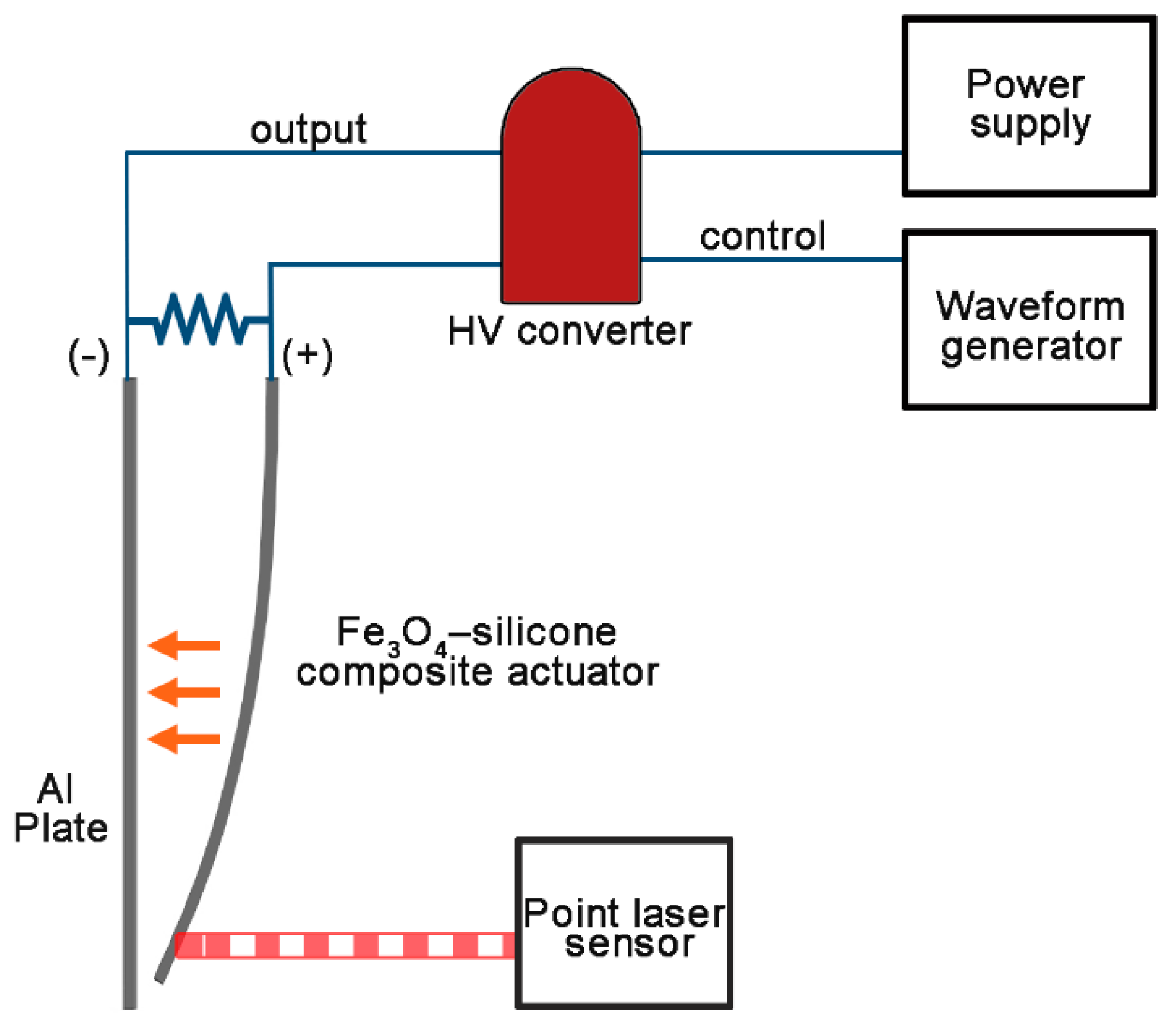
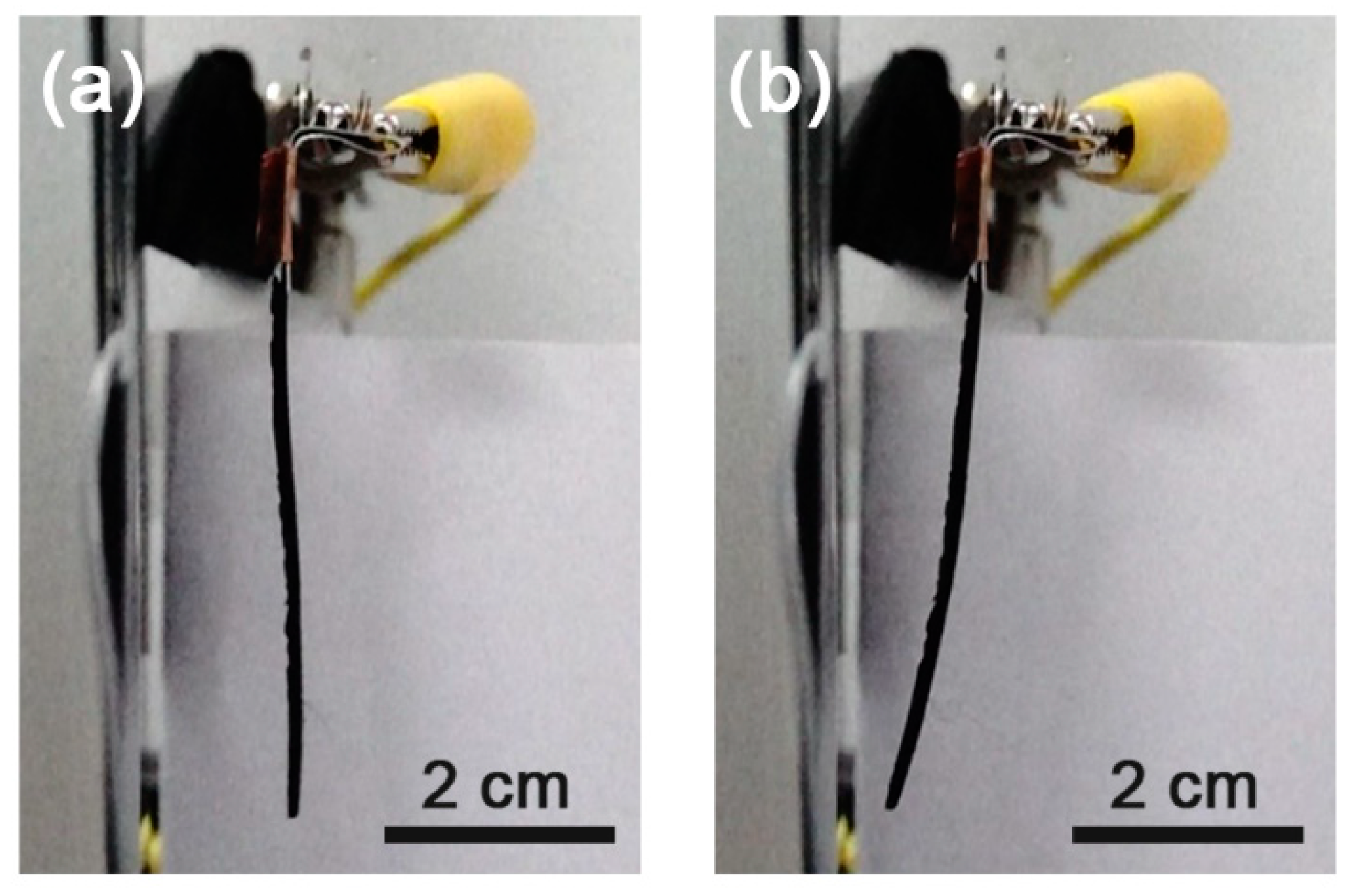
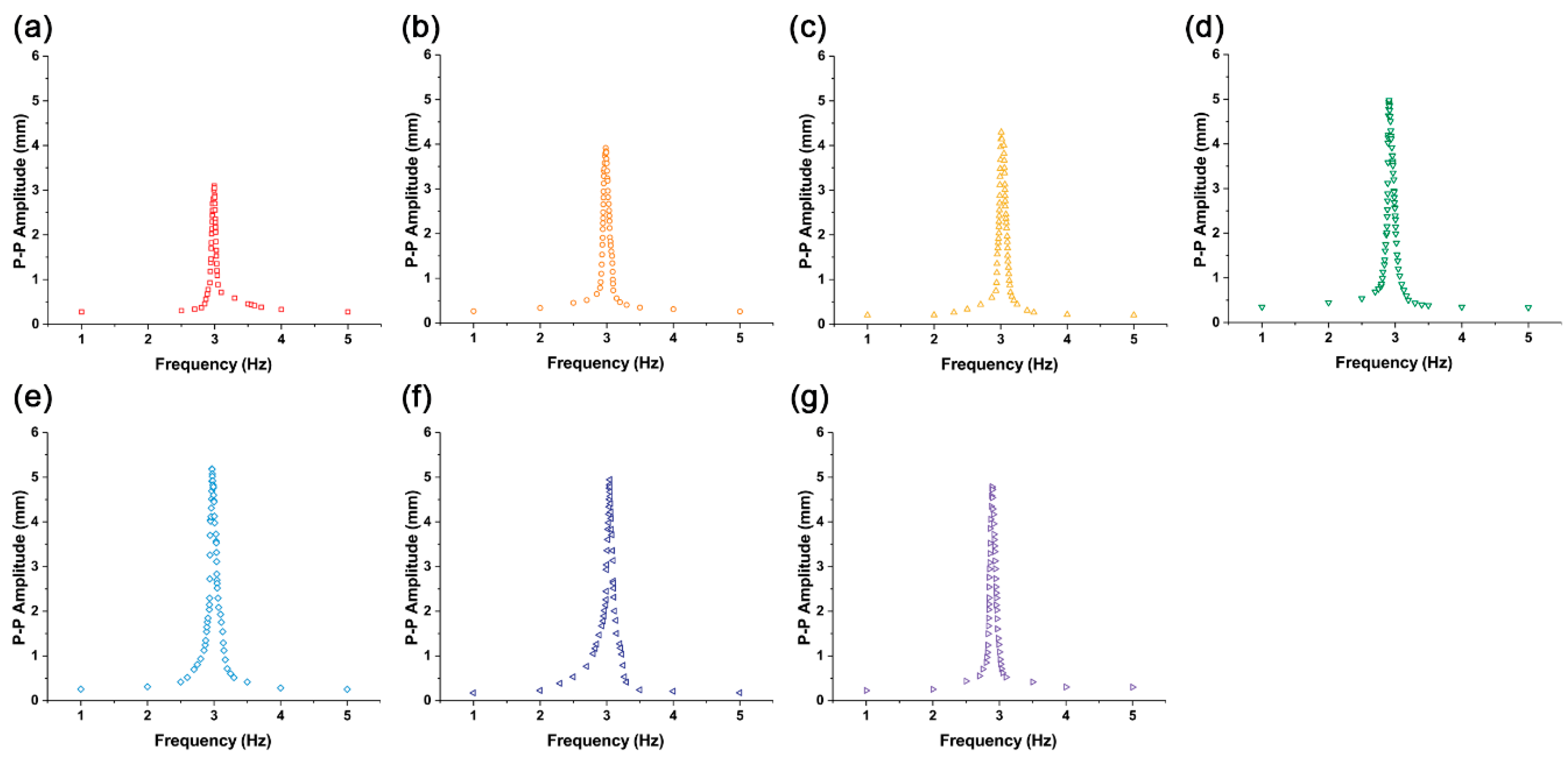

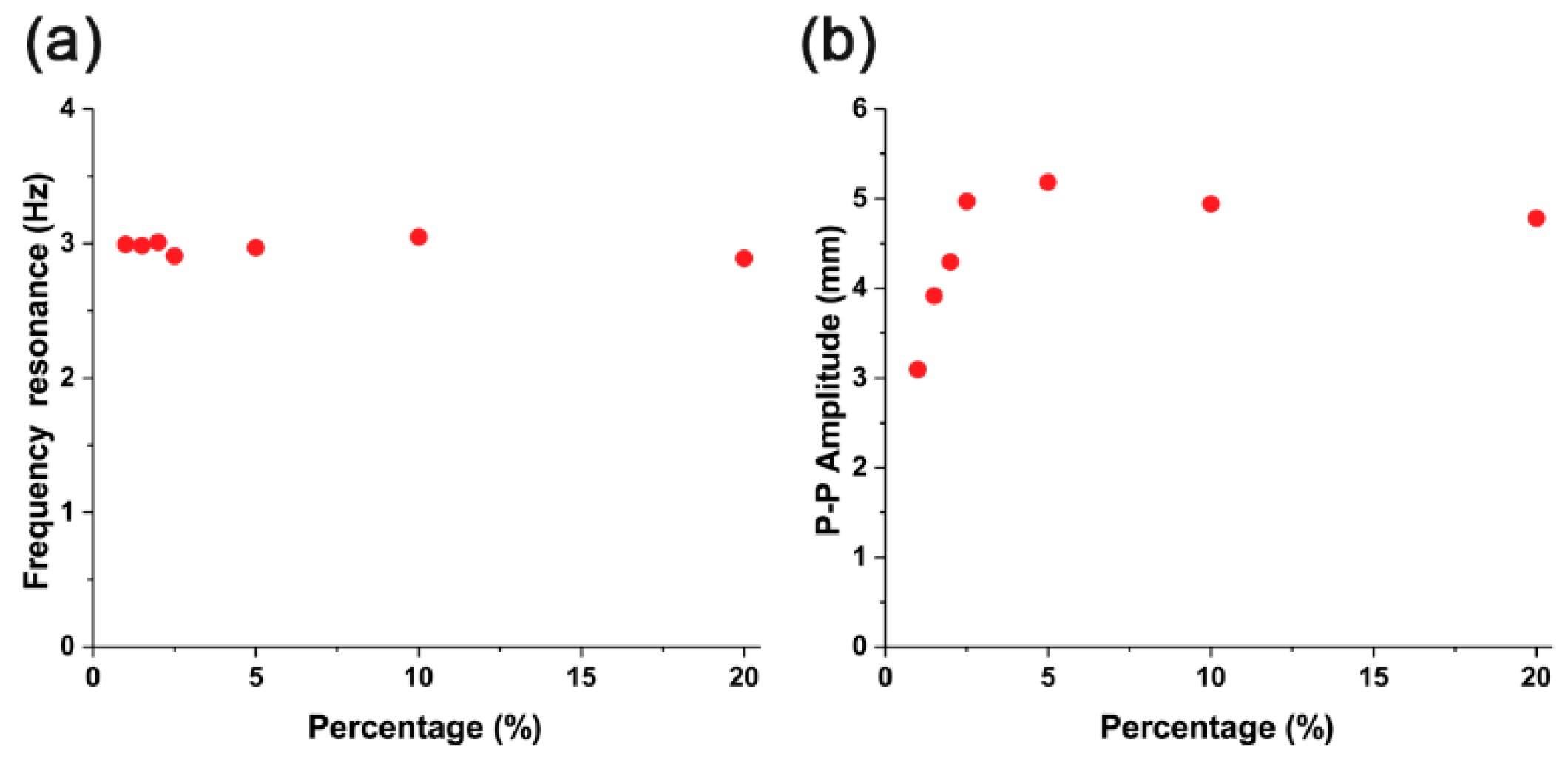
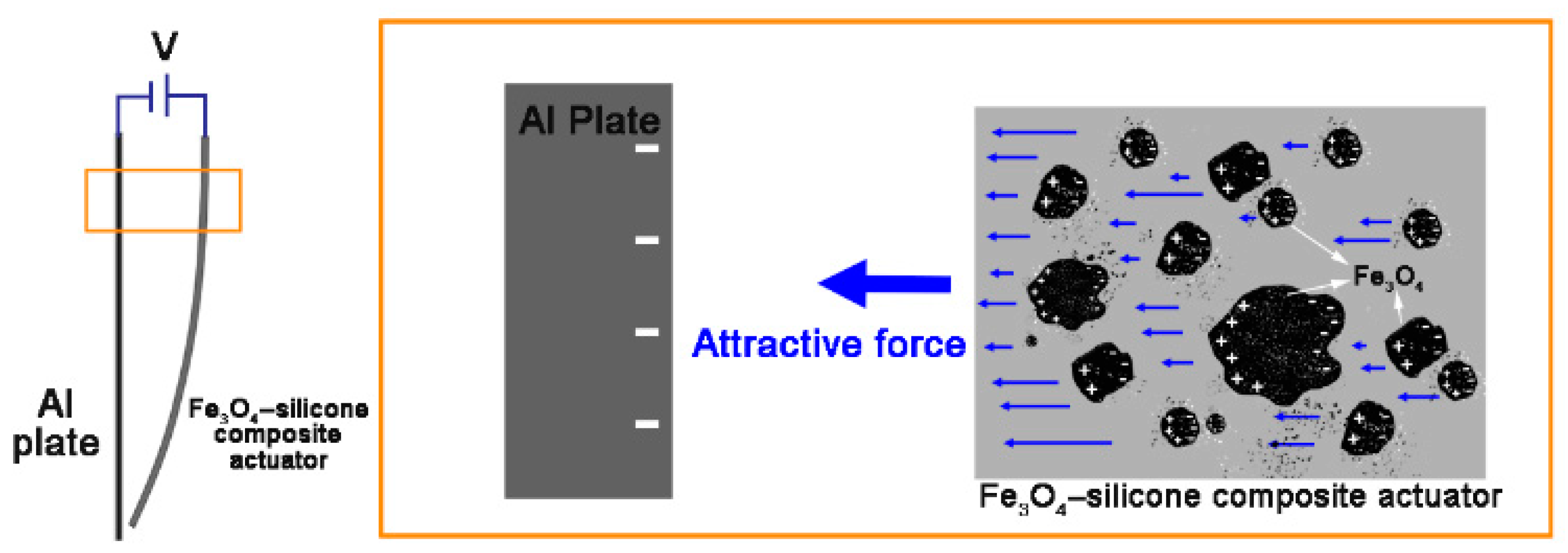
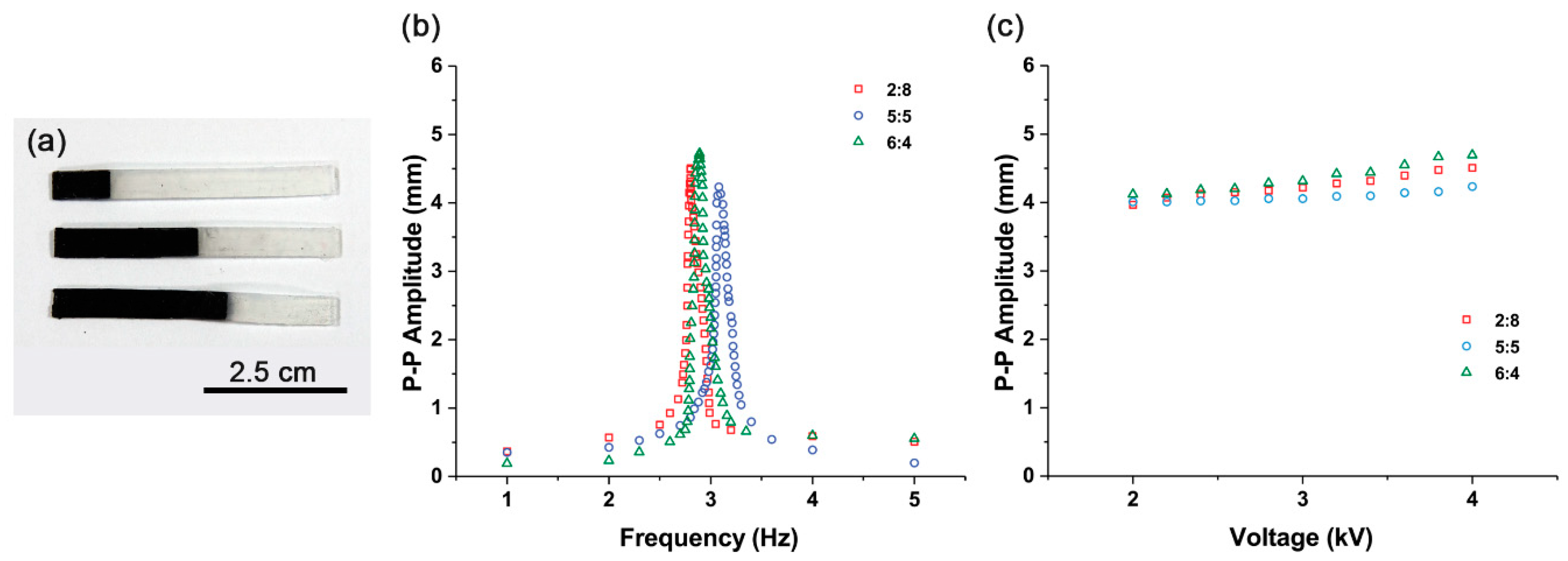
© 2018 by the authors. Licensee MDPI, Basel, Switzerland. This article is an open access article distributed under the terms and conditions of the Creative Commons Attribution (CC BY) license (http://creativecommons.org/licenses/by/4.0/).
Share and Cite
Song, K.; Cha, Y. Fe3O4–Silicone Mixture as Flexible Actuator. Materials 2018, 11, 753. https://doi.org/10.3390/ma11050753
Song K, Cha Y. Fe3O4–Silicone Mixture as Flexible Actuator. Materials. 2018; 11(5):753. https://doi.org/10.3390/ma11050753
Chicago/Turabian StyleSong, Kahye, and Youngsu Cha. 2018. "Fe3O4–Silicone Mixture as Flexible Actuator" Materials 11, no. 5: 753. https://doi.org/10.3390/ma11050753





